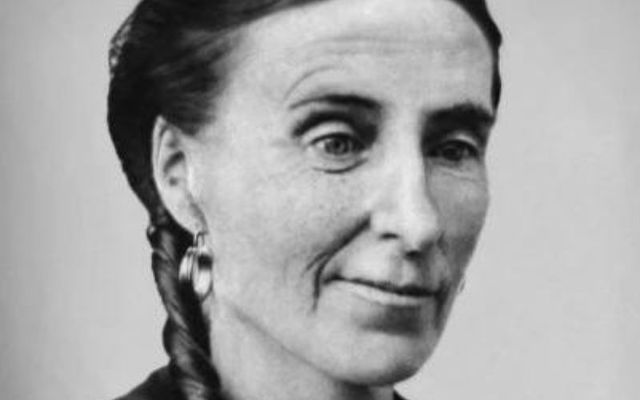Born in the small village of Stranorlar in County Donegal in January 1816, Frances Browne, the so-called ‘Blind Poetess of Ulster,’ overcame poverty, disability, and a lack of any formal education to become a fixture of the Victorian London literary scene, before fading into a long obscurity from which she has only recently been rescued.
An accomplished poet, novelist, and essayist, Browne, who lost her sight after a childhood bout of smallpox, is probably best known today for the patriotic verse "Songs of our Land."
Unlike other Irish nationalists of the era (such as the controversial, Confederacy-supporting Young Irelander John Mitchel), Browne combined her commitment to the Irish cause with support for the oppressed the world over, be they Poles suffering under Russian oppression, Jews facing discrimination all over Europe, or Cherokees being massacred and forcibly displaced from their lands by Manifest Destiny-era US governments.
Browne was also a staunch opponent of US slavery. Her 1846 poem "The Land of the Slave’" was inspired by the great abolitionist Frederick Douglass’s visit to Belfast, an event that has recently been commemorated through the erection of a statue to Douglass on Rosemary Street in the centre of the city, near one of the chapels at which he spoke.
About a decade later, Browne published another anti-slavery poem, "I Would That There Were Many Such," that portrayed, somewhat idealistically, a poor immigrant (the inference is that he is Irish) forgoing a large reward by refusing to divulge an escaping slave’s hiding place to his enslaver:
Yet not for all the dollars
That man may coin or see
Would I betray that flying slave
Thou evil man, to thee.
In the midst of the American Civil War, Browne returned to the topic of slavery in a short story called "An Experiment in the Peculiar Institution," the ‘peculiar institution’ being the anodyne expression Southerners gave the enslavement of millions of African Americans.
Her first novel, meanwhile, "My Share of the World," also written around this time, was partly concerned with the discomfort one of the main characters felt about their inherited wealth having been made in the slave trade; an unease shared by the present-day descendents of William Gladstone and other slavery-enriched British luminaries who are now expressing shame, offering apologies and, in some cases, seeking the means to make reparations.
Perhaps most notably, Browne was also the author (or ‘authoress’, as was the style of the time) of a children’s version of Harriet Beecher Stowe’s famous 1852 anti-slavery novel "Uncle Tom’s Cabin," stating in the preface how it was "designed to adapt Mrs. Stowe’s touching narrative to the understanding of the youngest readers and to foster in their hearts a generous sympathy for the wronged negro race of America." Titled "Uncle Tom’s Picture Book," this short, 36-page work interspersed passages from Stowe’s novel with original poems of Browne’s that described some of the pivotal scenes from the book, such as "The Sale of Little Harry," which reads in part:
The young child knew not what they said,
But at the open door
Eliza, his poor mother, stood,
With heart all sick and sore.
Oh children dear, ’twas sad to hear,
That for the trader’s gold,
To that hard-hearted evil man
Her own sweet boy was sold.
It seems likely Stowe approved of Browne’s adaptation, as it was released in America by her own publishers, having first come out in Britain.
And so, Browne, who would return to the world of children’s literature with the 1856 collection of fairy tales "Granny’s Wonderful Chair," carved out her own small place in the cultural phenomenon that was "Uncle Tom’s Cabin," the novel that was read aloud around innumerable 19th-century hearths and whose publication caused such a sensation that toy characters, playing cards, jigsaws, wallpaper and even crockery and cutlery inspired by its characters were quickly produced before being sold out in shops on both sides of the Atlantic.
Considered the first international bestseller written by an American, "Uncle Tom’s Cabin" counted Queen Victoria and Prince Albert amongst its legion of fans, the queen ensuring her private secretary arranged an ‘accidental’ meeting at King’s Cross railway station when Stowe visited London, the unusual venue allowing her to circumvent the diplomatic difficulties that would have stemmed from any official meeting with such a prominent abolitionist while the US still officially sanctioned slavery.
Although Browne never received a similar summons, she did manage to square her nationalist leanings with forging links with important politicians and aristocrats like Sir Robert Peel, Lord Lansdowne, and the Duchess of Sutherland (to whom "Uncle Tom’s Picture Book" was dedicated), their patronage facilitating her remarkable journey from a penurious postmaster’s house in the Finn Valley to the top table of literary London.
This article was submitted to the IrishCentral contributors network by a member of the global Irish community. To become an IrishCentral contributor click here.




Comments